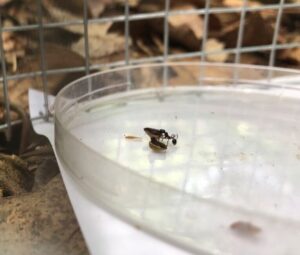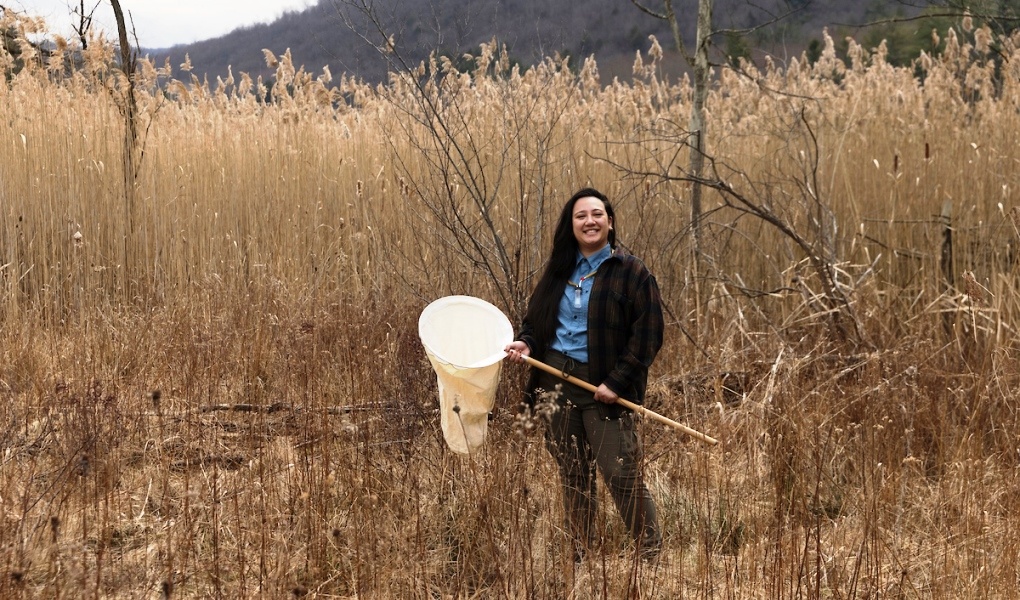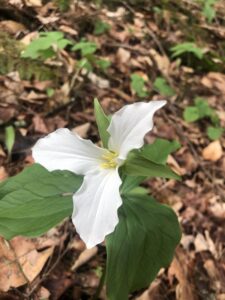Walk through an old growth forest in early spring, and you’ll be dazzled by wildflowers, their jewel-like tones shining from the forest floor.
But in newer forests, spring ephemerals such as trillium, wild ginger, violets and bloodroot are in shorter supply. The reason may lie with some less-flashy forest residents: Aphaenogaster sp., or the woodland ant.
Woodland ants are playing a greatly-underestimated role in forest regeneration, according to a new study led by Binghamton University.
The experts report that ants in the genus Aphaenogaster are powerful seed dispersers that mutually support understory plants such as native wildflowers.
 “Not a lot of people have heard of them, but they are the powerhouse of moving seeds and called ‘keystone dispersers,’” explained Carmela Buono, a Binghamton University doctoral candidate in biological sciences.
“Not a lot of people have heard of them, but they are the powerhouse of moving seeds and called ‘keystone dispersers,’” explained Carmela Buono, a Binghamton University doctoral candidate in biological sciences.
Buono is the lead author of “Historical forest disturbance results in variation in functional resilience of seed dispersal mutualisms,”.
It was recently published in Ecology, and co-authored with Binghamton University Assistant Professor of Biological Sciences Kirsten Prior and undergraduates Jesse Lofaso, Will Smisko, Carly Gerth and John Santare.
Together, the team measured understory plants and seed dispersal by ants in 20 New York state forests, half-old growth and half-regenerated.
More than 95% of New York state forests — including the Binghamton University Nature Preserve — are secondary forests, which sprung up on land once cleared for agriculture.
While parts of these regenerated forests, such as the overstory, have recovered well, they are missing other aspects of biodiversity — particularly when it comes to understory plants such as native wildflowers.
Many plant species rely on a mutual relationship with ants to disperse their seeds.
In fact, northeastern North America is one of the major hotspots of ant-plant mutualism, although it also happens in parts of Europe, Australia, South Africa and in northeastern Asia, Buono said.
“These plants evolved with seeds that have an appendage rich in fats attached to them, and that’s very attractive to woodland ants,” she said. “Ants need fats just as much as protein and sugar, and it’s hard to find foods rich in fats in the forest.”
Shiny black and medium-sized, woodland ants are a native species that lives in logs, forest leaf litter and underneath rocks.
Woodland ants take the seeds with fatty rewards back to their nests, protecting them from consumption by rodents and other organisms.
Once the fatty appendages are consumed, the ants — in a kind of insect housekeeping — remove the seeds from the nest, dispersing them far from the original plant. It’s a mutually beneficial arrangement.
“There are so many interesting, intricate parts of this interaction depending on the types of seeds ants prefer, so you can get this beautiful mixing of flower species in forests,” Buono said.
How are old growth forests different?
Old growth forests are rare treasures that play an important role in preserving species diversity, Buono pointed out. Pockets of the Northeast’s ancient forest cover remain in some areas, often on land deemed unsuitable for farming.
They differ from secondary forests literally starting at the ground level. Ground previously cleared for agriculture is flat, whereas old growth forests have a “pit and mound” topography.
“It’s uneven, from years and years of trees falling over,” Buono explained.
The pits are left from the roots of toppled trees lifted out of the ground, while mounds result from the extracted root and soil. Species within the two types of forest are also different, with quick colonizers moving into younger woodlands. An established forest often features a greater number of shade-tolerant plants in the understory.
There are slightly fewer woodland ants in secondary forests, perhaps owing to their displacement during years of agricultural use. Differences in forest canopies and the amount of light that reaches the forest floor could also play a role, but that has yet to be explored, Buono said.
The real issue appears to be competition with invasive slugs, which are found largely in the regenerated woodlands and also have a taste for fatty seed appendages. Slugs often prefer forest edges, and secondary forests may be located closer to habitats that slugs prefer, such as open meadows or active farms, Buono said.
“Ants are beneficial. They’re not as charismatic as butterflies or bees that help pollinate flowers, but they are just as important,” Buono said.
To restore newer forests to a healthier state, we need to look beyond the trees to the diversity of insects, which play a crucial role in the forest ecosystem, according to the researchers.
ABSTRACT
Mutualistic interactions provide essential ecosystem functions that contribute to promoting and maintaining diversity in ecosystems. Understanding if functionally important mutualisms are “resilient” (i.e., able to resist or recover) to anthropogenic disturbance is essential for revealing the capacity for diversity to recover. Animal-mediated seed dispersal supports plant population growth and influences community structure, and disturbance affecting seed dispersal can contribute to low resiliency of plant diversity. Ant–seed dispersal mutualisms are sensitive to anthropogenic disturbance, as they rely on one to a few high-quality dispersal partners.
In North American eastern deciduous forests, ants in the genus Aphaenogaster are “keystone dispersers” of understory forbs adapted to dispersal by ants (myrmecochores), which make up more than one-third of the understory herbaceous community. The majority of forests within this region have regenerated from previous disturbance in the form of clearing for agriculture. Previous studies have revealed that myrmecochore diversity is not resilient to previous clearing. Here, we ask if seed dispersal mutualisms are resilient to historical forest disturbance and if decreases in mutualistic interactions with partners, Aphaenogaster sp., or increases in antagonistic interactions cause degradation of function.
In a large-scale natural experiment (20 sites), we measured seed removal, the abundance of mutualistic partners and other invertebrates interacting with seeds, myrmecochore cover, and diversity, along with ant habitat and forest structure. We found lower and more variable seed removal in secondary forests compared with remnant forests. A path analysis of all forests revealed that the abundance of mutualists was the primary determinant of the variation in seed removal, and that seed damage by antagonists (invasive slugs) negatively affected dispersal and was higher in secondary forests.
In a path analysis of remnant forests, the link between mutualist abundance and seed removal was absent, but present in the secondary forest path, suggesting that seed dispersal is more variable and dependent on the mutualist abundance in secondary forests and is stable and high in remnant forests. Our results suggest that functional resilience to disturbance is variable, where seed dispersal is low in some secondary forests and not others. This work provides key insights into the effects of disturbance on mutualistic interactions and how the resilience of critical ecosystem functions impacts the capacity for diversity resiliency.
All photos courtesy of Binghamton University.


